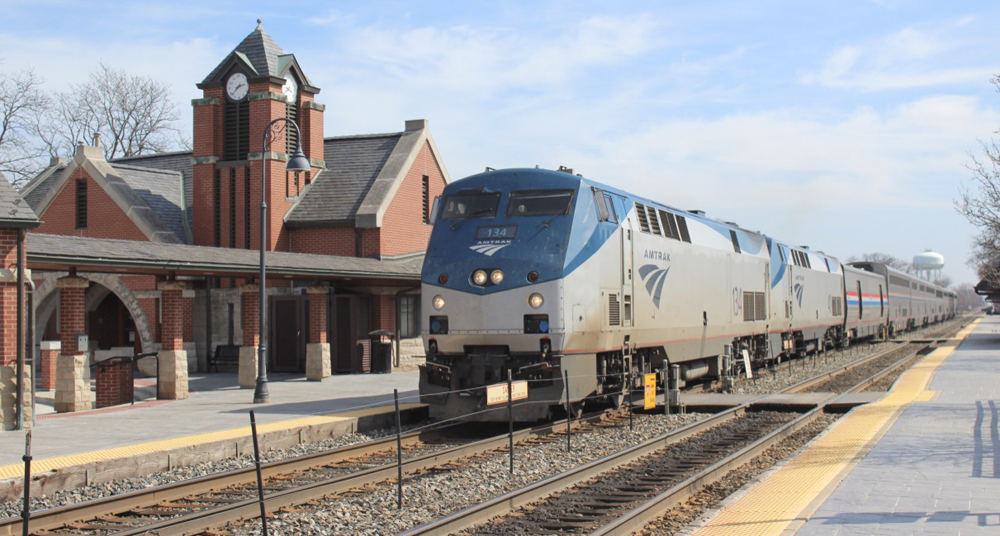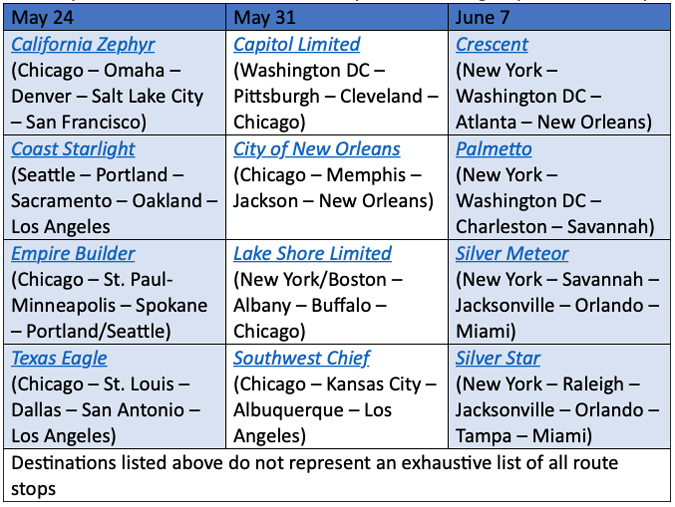
WASHINGTON — Anyone ready to lock in summer travel plans that involve long-distance trains will find lower fares on days that have had no service since last October.
Amtrak wasted no time Wednesday in complying with marching orders from Congress in the just-passed economic stimulus legislation, immediately announcing when it would resume daily service on 12 routes and placing on sale coach and sleeping-car inventory for the four additional days. The restored service begins May 24, May 31, or June 7, depending on the route [see “Amtrak announces dates to restore daily service on 12 long-distance routes,” Trains News Wire, March 10, and the schedule below].
Because the company uses a yield management pricing strategy, which raises fares as demand increases, most fares were already high on the three days each week these trains were scheduled to operate. Conversely, with no tickets having been sold on the other days, fares are low.
For instance, Chicago-Seattle fares for the Empire Builder departing Chicago on Monday, June ,7 is $245 in coach, already showing a 30% sellout. In sleeping cars, prices are $1,074 for one adult in a roomette, and $1,816 in a family room. No bedrooms are available.
The next day, when the train previously had not been scheduled to run, fares are $150 in coach (0% sellout), $651 in a roomette, $842 in a family room (one available at that price), and $1,210 for a Superliner bedroom (two at that price).

Amtrak
Roger Harris, Amtrak’s executive vice president and chief marketing and revenue officer, admits that even with reduced frequencies, “Long distance has been the star of the network,” and is confident demand will fill the seats and rooms at close to previous years’ prices. He tells Trains News Wire, “Under our original restoration metrics, we needed to see forward load factor bookings within 10% of historical levels, and we are actually ahead of that for this summer.”
That’s the main reason fares will not be drastically reduced across the board. Another is that Amtrak’s board of directors had already approved an additional $10 million for advertising.
“We’re going back into diversified media channels such as radio and television that we had de-emphasized in recent years; not in a big way but we are going back to an extent, along with a more targeted digital advertising approach,” says Harris. “It’s starting in March, because that’s when people begin planning trips and buying tickets.”
He also says that if unsold space remains, Amtrak plans within a few months to auction otherwise unsold sleeping-car rooms using the recently announced “BidUp” coach upgrade feature [see, “Amtrak now offers passengers a chance to bid on upgrades,” News Wire, Feb. 24, 2021].
Food service under review

Bob Johnston
Amtrak plans to restore “traditional” dining car meals with the daily frequencies, Harris says, “but we’re not quite sure yet how to work through the health implications. Communal dining is probably a non-starter for now, and you can work backward through food preparation and delivery.”
He says Amtrak’s new head of customer service, Robert Jordan, “is very interested in the topic and is going through the process of inviting employee input to make it better.”
“It’s important to figure this out because it involves the recall of employees for the daily service this summer, so it’s a rather intertwined process,” Harris says. “There will be some food service decisions in the coming months but there will be further developments in the next year, as we get our new team really focused on this.”














Unless and until the host carriers can allow Amtrack to maintain ‘PSR’ that is actually observed, the operation is going to have an insoluble problem. The bald fact is that so much physical plant, equipment and personnel have been eliminated that passenger rail has been effectively removed as a reliable mode where it is subject to the whims of host carriers. It is the unwanted step-child of neglect.
In 1970 part of the allure of NRPC in was erasing private railroads’ passenger train deficits. With the possible exception of alcohol sales, I’ve never read of a railroad making money on dining car sales; butts in seats and beds made up the difference.
If Amtrak [AND its “host railroads”] is to operate efficiently, host railroads should be charged with higher late fees. Perhaps after a few strong hits to their wallets the railroads will learn that running Amtrak trains on schedule will help them to better plan their freight movements? Better efficiency = more cash in the till at the end of the year.
Read Amtrak’s definition of “traditional dining” on the company’s website; it means dishes prepared by an on-board chef.
Please don’t forget that although Amtrak maintains that the reduction in food service was Pandemic related, the facts do not support that premise. The latest reductions in food service did occur on long distance trains with the growth of Covid-19 starting in the spring of 2020. But the reduction of food service system wide on Viewliner routes started several years ago with the elimination of the dining car on the Silver Meteor. The confused management team at Amtrak began using the new Viewliner diners that were commissioned under Joe Boardman’s term as CEO and delivered beginning about 18 months ago (sadly the last car type delivered from that order) as “table cars”. Spent all that production money for no food service revenue. Whatever the agenda of this management team of former Airline managers, any type of food service program that could reasonably satisfy the customer and increase the amount of ridership (revenue) is NOT in it.
Awesome news, and maybe I will finally get on City of New Orleans later in summer, tried 2 years ago but Bonne Carre Spillway open for 93 days and I did not want a bus from Jackson, last year too much Covid and I was at risk anyway. Third time may be a charm. I have points to redeem too.
Finally some good news out of Amtrak. Not sure what “traditional” means but it can’t be worse than the box dinners they serve now.
“Original” dining is essential on the western LD the eastern LD could probably have some new palatable alternatives.
Whatever they mean by “traditional” it should be on ALL trains.
Good news!
Re Dining Car meals – What does “traditional” mean? Whose tradition?
Great news again, but I wish they would stop that pricing strategy. It scares some people off and looks like a money grab, you want it you have to pay more for it.